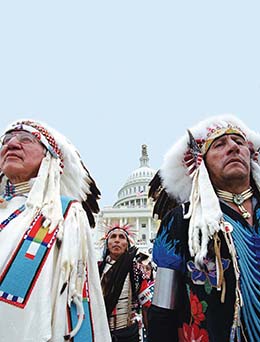American Issues  Connector: American Indian Policy
Connector: American Indian Policy

Native Americans in traditional garb press for Indian rights in Washington, D.C.
TRACK THE ISSUE
![]() How should the federal government deal with Indian nations?
How should the federal government deal with Indian nations?
From its earliest days, the federal government has grappled with the issue of relations with Native Americans. Since Indians in the West were forced to move onto reservations, government policy has shifted several times. Use the timeline below to explore this enduring issue.
-
1787 U.S. Constitution
Federal government given power to regulate trade with Native Americans.
-
1824 Bureau of Indian Affairs
Agency created to handle relations with Native Americans.
-
1887 Dawes Act
Government divides reservations into individual land holdings.
-
1934 Indian Reorganization Act
Tribal governments gain more control over own affairs.
-
1975 Indian Self-Determination and Educational Assistance Act
Indians win control over schools and other government services.

Comanche girls, 1892
DEBATE THE ISSUE
Native American Land Claims Today, several Native American nations have made claims to their original lands, arguing that old treaties were illegal. Opponents say that to recognize these claims after so many years would lead to injustice to the people now living on those lands.
“For over 200 years, we have endured hardship and indignities from the unjust taking of our ancestral land. We have been confined to a small reservation. We have suffered the painful loss of our traditional way of life…. There will be no actions to evict our neighbors from their homes as we know all too well the pain and suffering displacement causes.”
—Tadodaho (Sidney Hill) of the Onondaga Nation, March 10, 2005
“Employing a unique body of laws, today’s courts have decided to hear cases based on alleged violations of federal law that occurred over 200 years ago. Even more incredible than the ability and willingness of our judicial system to resurrect these ancient claims, is its [tendency] to apply modern legal interpretations to ancient events and blatantly disregard the historical record.”
—Scott Peterman, May 25, 2002
 TRANSFER Activities
TRANSFER Activities
- Compare How do Tadodaho and Peterman differ on the subject of land claims?
- Analyze How do you think Tadodaho would view the Dawes Act?
- Transfer Use the following Web site to see a video, try a WebQuest, and write in your journal. Web Code: neh-7502




